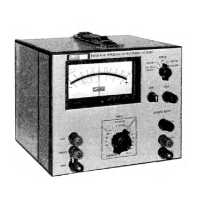845A
b. Turn
the recorder
on.
c. Proceed
as
outlined in
paragraph
2-13
or
2~15,
as
desired.
d.
Adjust the ISOLATED
OUTPUT LEVEL control for
the
desired
output
to
the recorder. This control
has
a log taper so
that smooth control is possible
at
both high and low settings.
and forth will dissipate this
charge, eliminating the
problem, Witii a high source
impedance,
the
response
of the instiTiment
is unavoidably
slow due
to
the
low
pass
filter used to
suppress superimposed
noise.
However,
the design of the low
pass
filter
is such
that
common
mode
rejection
is
extremely
high
while
the
response
time
for the
normally encountered low source imped-
ances is very fast.
2-31.
OVERLOAD
VOLTAGES
The ISOLATED OUTPUT current capability
is 100 microan^eres
with
a
5
kilohm source
impedance.
2-24.
OPERATING
NOTES
2-25.
SPURIOUS
VOLTAGES
AND CURRENTS
2-26,
Voltage measurements at
the
microvolt
level
involve
the
persistant
problems
of
thermoelectric ef-
fects. These
effects
may
be
compensated for by tempo-
rarily disconnecting the
voltage
from
the circuit under
measurement
and
noting the meter deflection of the
Model
845
on
the
desired
range. This reading
must
then be
subtracted from all subsequent voltage measure-
ments. A
thorough understanding of these effects
can
lead to reducing or
eliminating them completely.
2-27.
THERMOELECTRIC VOLTAGES
2-28.
Ha
circuit
is
composed of two dissimilar metals,
a
net voltage
will result if
the
two dissimilar junctions
are maintained at different
temperatures. These
ther-
moelectric voltages, also
known
as
thermals, thermo-
couple voltages,
or
Seebeck voltages, can be
reduced
by using metals having low thermoelectric potentials and
keeping all junctions
at
the
same
temperature. The
terminals of the Model 845 are
made
of pure copper,
gold-flashed to prevent
tarnish. For
lowest
thermal
voltages, all connections to
the
Model
845 should
be
made
with
pure copper wire. Silver plated copper
or
solder coated copper also produce
satisfactory results.
Tinned copper is less satisfactory
than silver plated or
solder
coated
copper
.
Nickel and nickel- based alloys
are
not
suitable for connections
to
the instrximent. Ex-
cellent results can be obtained
using
ordinary
TV twin
lead, or even lamp cord if high
insulation resistance
is
not required, if shielding
is
necessary, use a
length
of flat braid over the cable.
2-29.
HIGH
SOURCE
IMPEDANCE
2-30.
Due to
the
very
high input resistance and ex-
treme sensitivity of the Model
845,
it
is charge
sensi-
tive.
Thus, a person’s body
potential,
an
electrostatic
voltage,
can cause charge redistribution at the input to
the instrument and
result in meter needle deflection
as
a hand approaches
the input
terminals. Careful shielding
will eliminate this problem. Also, due to charges
that
may
be
deposited on the input terminals
when
the OPR
switch
is set to
ZERO,
an
appreciable transient will
result when the switch is set
to
OPR
if
nothing
is con-
nected to the input
terminals.
Turning
the switch back
2-32.
The
instrument
is
designed
to
withstand
up to
HOO volts dc
or 1100 volts
peak
ac
continuously
applied
between
any two
of the three input
terminals,
or
between
cabinet
ground and
any
of the three
input terminals,
regardless of the
setting
of
the
RANGE or OPR
switch.
However,
repeated
or continuous
overloads
above 200
volts in the
ranges below 3 millivolts will
result
in ex-
cessive
dissipation in the
protective, low
-pass -filter
resistor
RllO. This will
result in thermal
voltages
which
may take several
minutes
to
subside
after the
overload
is
removed.
2-33.
GUARDING
2-34.
The instrument
has an inner chassis connected
to
the
GUARD terminal
on the front panel. Ordinarily,
this
GUARD terminal
is
striped
to
the
COMMON
termi-
nal. When connected
in
this
way,
the
inner
chassis
serves
as a
shield. This greatly
improves the leakage
resistance
to ground and the common
mode rejection.
However, since the inner
chassis
is available at the
GUARD
terminal, it
may be driven at the same voltage
as
the
COMMON terminal. This further
increases the
leakage resistance
and common
mode
rejection
by
about
ten
times. The voltage
used to
drive the
GUARD
termi-
nal should
be
obtained
from a separate source or by
means
of
a voltage divider connected directly
across
the
source so that the leakage currents
do
not
cause
voltage
drops across impedances
in
the
circuit
under
measurement.
2-35.
INCREASING
INPUT RESISTANCE
2-36.
In
the
1
microvolt to
i
millivolt
ranges,
a
10
megohm
resistor
is
connected directly
across the input
of the
instrument.
The input resistance
may
be in-
creased
on these ranges by disconnecting the
10
megohm
resistor
where it attaches to the
RANGE switch.
How-
ever, the input
resistance
will
no longer
be
well
defined.
Typical input
resistances with
the 10 megohm
resistor
removed, are
as follows:
RANGE INPUT RESISTANCE
1
microvolt
3 microvolt
10 microvolt
30 microvolt
to 1
millivolt
300
megohms
1000 megohms
3000 megohms
10,
000
megohms
2-5

